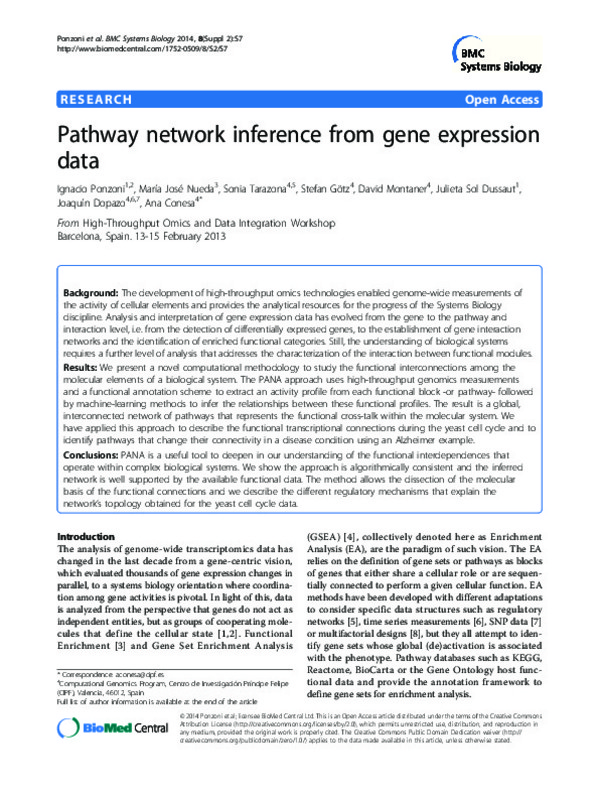Ponzoni, I.; Nueda, MJ.; Tarazona Campos, S.; Gotz, S.; Montaner, D.; Dussaut, JS.; Dopazo, J.... (2014). Pathway network inference from gene expression data. BMC Systems Biology. 8(2):1-17. https://doi.org/10.1186/1752-0509-8-S2-S7
Por favor, use este identificador para citar o enlazar este ítem: http://hdl.handle.net/10251/63850
|
Título:
|
Pathway network inference from gene expression data
|
|
Autor:
|
Ponzoni, Ignacio
Nueda, Maria José

 Tarazona Campos, Sonia
GOTZ, STEFAN
Montaner, David
Dussaut, Julieta Sol
Dopazo, Joaquín
Conesa, Ana
Tarazona Campos, Sonia
GOTZ, STEFAN
Montaner, David
Dussaut, Julieta Sol
Dopazo, Joaquín
Conesa, Ana
|
|
Entidad UPV:
|
Universitat Politècnica de València. Departamento de Estadística e Investigación Operativa Aplicadas y Calidad - Departament d'Estadística i Investigació Operativa Aplicades i Qualitat
Universitat Politècnica de València. Departamento de Física Aplicada - Departament de Física Aplicada
|
|
Fecha difusión:
|
|
|
Resumen:
|
[EN] Background: The development of high-throughput omics technologies enabled genome-wide measurements of
the activity of cellular elements and provides the analytical resources for the progress of the Systems ...[+]
[EN] Background: The development of high-throughput omics technologies enabled genome-wide measurements of
the activity of cellular elements and provides the analytical resources for the progress of the Systems Biology
discipline. Analysis and interpretation of gene expression data has evolved from the gene to the pathway and
interaction level, i.e. from the detection of differentially expressed genes, to the establishment of gene interaction
networks and the identification of enriched functional categories. Still, the understanding of biological systems
requires a further level of analysis that addresses the characterization of the interaction between functional modules.
Results: We present a novel computational methodology to study the functional interconnections among the
molecular elements of a biological system. The PANA approach uses high-throughput genomics measurements
and a functional annotation scheme to extract an activity profile from each functional block -or pathway- followed
by machine-learning methods to infer the relationships between these functional profiles. The result is a global,
interconnected network of pathways that represents the functional cross-talk within the molecular system. We
have applied this approach to describe the functional transcriptional connections during the yeast cell cycle and to
identify pathways that change their connectivity in a disease condition using an Alzheimer example.
Conclusions: PANA is a useful tool to deepen in our understanding of the functional interdependences that
operate within complex biological systems. We show the approach is algorithmically consistent and the inferred
network is well supported by the available functional data. The method allows the dissection of the molecular
basis of the functional connections and we describe the different regulatory mechanisms that explain the
network’s topology obtained for the yeast cell cycle data.
[-]
|
|
Palabras clave:
|
Alzheimers-Disease
,
Saccharomyces-Cervisiae
,
S-phase
,
Microarray experiments
,
Ubiquitin conjugation
,
Functional assessment
,
Sister chromatids
,
DNA-replication
,
Genomic data
,
R package
|
|
Derechos de uso:
|
Reconocimiento (by)
|
|
Fuente:
|
BMC Systems Biology. (issn:
1752-0509
)
|
|
DOI:
|
10.1186/1752-0509-8-S2-S7
|
|
Editorial:
|
BioMed Central
|
|
Versión del editor:
|
http://dx.doi.org/10.1186/1752-0509-8-S2-S7
|
|
Código del Proyecto:
|
info:eu-repo/grantAgreement/CONICET//PIP 11220090100322/
info:eu-repo/grantAgreement/EC/FP7/306000/EU/User-driven Development of Statistical Methods for Experimental Planning, Data Gathering, and Integrative Analysis of Next Generation Sequencing, Proteomics and Metabolomics data/
info:eu-repo/grantAgreement/UNS//PGI 24%2FN032/
|
|
Descripción:
|
This article has been published as part of BMC Systems Biology Volume 8
Supplement 2, 2014: Selected articles from the High-Throughput Omics and
Data Integration Workshop. The full contents of the supplement are available
online at http://www.biomedcentral.com/bmcsystbiol/supplements/8/S2.
|
|
Agradecimientos:
|
This work has been supported by the FP7 STATegra project, grant 306000, by CONICET (National Research Council of Argentina), grant PIP112-2009-0100322, and by Universidad Nacional del Sur (Bahía Blanca, Argentina), grant ...[+]
This work has been supported by the FP7 STATegra project, grant 306000, by CONICET (National Research Council of Argentina), grant PIP112-2009-0100322, and by Universidad Nacional del Sur (Bahía Blanca, Argentina), grant PGI 24/N032. The publication costs for this article were funded by the FP7 STATegra project, grant 306000.
[-]
|
|
Tipo:
|
Artículo
|









